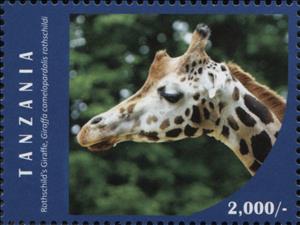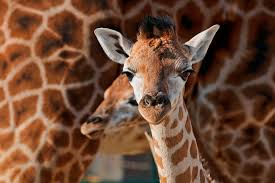Stamp: Rothschild's Giraffe (Giraffa camelopardalis rothschildi) (Tanzania 2016)
Rothschild's Giraffe (Giraffa camelopardalis rothschildi) (Tanzania 2016)
28 January (Tanzania ) within release Endangered Animals of Africa (2016) goes into circulation Stamp Rothschild's Giraffe (Giraffa camelopardalis rothschildi) face value 2,000 Tanzanian shilling
| Stamp Rothschild's Giraffe (Giraffa camelopardalis rothschildi) in catalogues | |
|---|---|
| Michel: | Mi: TZ 5227 |
| WADP Numbering System - WNS: | WAD: TZ 043.16 |
Stamp is horizontal format.
Although authorised by the Tanzanian Postal Administration this issue was only distributed by Tansania's philatelic agency to the novelty trade.Also in the issue Endangered Animals of Africa (2016):
- Mini Sheet - Endangered Animals of Africa face value 4*2000;
- Stamp - Grevy's Zebra (Equus grevyi) face value 2,000;
- Stamp - African Penguin (Spheniscus demersus) face value 2,000;
- Stamp - Rothschild's Giraffe (Giraffa camelopardalis rothschildi) face value 2,000;
- Stamp - Western Lowland Gorilla (Gorilla gorilla gorilla) face value 2,000;
- Mini Sheet - Endangered Animals of Africa face value 4*2000;
- Stamp - Greater Bamboo Lemur (Prolemur simus) face value 2,000;
- Stamp - Radiated Tortoise (Astrochelys radiata) face value 2,000;
- Stamp - Dama Gazelle (Nanger dama) face value 2,000;
- Stamp - African Wild Dog (Lycaon pictus) face value 2,000;
- Stamp - Black Rhinozeros (Diceros bicornis) face value 3,000;
- Stamp - Mountain Gorilla (Gorilla beringei beringei) face value 3,000;
- Stamp - Addax (Addax nasomaculatus) face value 3,000;
- Stamp - Geometric Tortoise (Psammobates geometricus) face value 3,000;
- Souvenir Sheet - Endangered Animals of Africa face value 2*3000;
- Souvenir Sheet - Endangered Animals of Africa face value 2*3000;
Stamp Rothschild's Giraffe (Giraffa camelopardalis rothschildi) it reflects the thematic directions:
Animals are multicellular, eukaryotic organisms of the kingdom Animalia (also called Metazoa). All animals are motile, meaning they can move spontaneously and independently, at some point in their lives. Their body plan eventually becomes fixed as they develop, although some undergo a process of metamorphosis later on in their lives. All animals are heterotrophs: they must ingest other organisms or their products for sustenance.
The giraffe is a large African hoofed mammal belonging to the genus Giraffa. It is the tallest living terrestrial animal and the largest ruminant on Earth. Traditionally, giraffes have been thought of as one species, Giraffa camelopardalis, with nine subspecies. Most recently, researchers proposed dividing them into up to eight extant species due to new research into their mitochondrial and nuclear DNA, and individual species can be distinguished by their fur coat patterns. Seven other extinct species of Giraffa are known from the fossil record
Mammals are any vertebrates within the class Mammalia (/məˈmeɪli.ə/ from Latin mamma "breast"), a clade of endothermic amniotes distinguished from reptiles (including birds) by the possession of a neocortex (a region of the brain), hair, three middle ear bones and mammary glands. All female mammals nurse their young with milk, secreted from the mammary glands. Mammals include the largest animals on the planet, the great whales. The basic body type is a terrestrial quadruped, but some mammals are adapted for life at sea, in the air, in trees, underground or on two legs. The largest group of mammals, the placentals, have a placenta, which enables the feeding of the fetus during gestation. Mammals range in size from the 30–40 mm (1.2–1.6 in) bumblebee bat to the 30-meter (98 ft) blue whale. With the exception of the five species of monotreme (egg-laying mammals), all modern mammals give birth to live young. Most mammals, including the six most species-rich orders, belong to the placental group. The largest orders are the rodents, bats and Soricomorpha (shrews and allies). The next three biggest orders, depending on the biological classification scheme used, are the Primates (apes and monkeys), the Cetartiodactyla (whales and even-toed ungulates), and the Carnivora (cats, dogs, seals, and allies).



